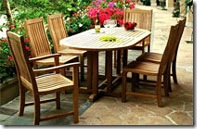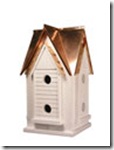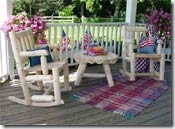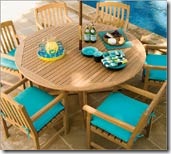If you are looking for patio furniture, your head may be spinning. There are more choices now than ever before, it seems. Here are a few pointers that will set you on the right path:
FSC Certified means that the item you are looking at is certified by the board of the Forest Stewardship Council. The FSC sets forth principles, criteria, and standards that span economic, social, and environmental concerns. The FSC standards represent the world’s strongest system for guiding forest management toward sustainable outcomes.
Reclaimed wood is a great alternative. Look for this verbiage when buying any wooden item. This phrase means that the product is made of scraps, rather than new wood.
Softwood refers to the wood from needle bearing trees. Hardwood describes wood from trees having broad leaves. This is not to be confused with the texture of the wood itself.
- Willow, cypress, alder and other trees with pliable branches are commonly used for bent-twig furniture. Willow is especially renewable. When it is cut, two or more shoots will grow out of the stump of the cut piece. If you use twig furniture outdoors, spray or brush on a good quality clear exterior varnish and use the furniture only in a protected area.
- Pine is an affordable softwood that is harvested in several varieties from around the world. It is most commonly from American forests. All are yellow with brown knots and are perfect for staining. Pressure-treated pine will last for 20 years but untreated pine has low rot-resistance. It needs to be painted, stained or sealed and stored inside in the winter.
- Tropical eucalyptus is a native of Australia and is prized for its resistance to rot and handsome attributes. It will last decades. Tropical hardwoods will safely weather to a silvery finish over time. To preserve the original color simply treat twice a year with teak or other furniture oil.

- Roble is a golden, relatively lightweight hardwood harvested mainly from dry tropical forests in South America. It will last up to 25 years.
- Shorea, grown in Indonesia and Malaysia, is stronger and heavier than teak but because of the large quantity available, is usually priced lower. Both jarrah wood and shorea will last up for up to 50 years.
- Jarrah has a reddish or pinkish color and is harvested in Australia from government-managed forests to ensure reforestation.
- Teak is the most desired of all outdoor furniture woods for its honey brown hardwood that is highly resistant to rot and decay. It will last more than 50 years, even if left outdoors year-round. Teak is now harvested primarily from plantations in Southeast Asia. Dwindling stocks and high consumer demand have combined to make the price of teak soar.
 The high price of teak has made other tropical hardwoods, such as roble, shorea, jarrah and eucalyptus popular. All of these woods are dense, durable, and stand up well to weather.
The high price of teak has made other tropical hardwoods, such as roble, shorea, jarrah and eucalyptus popular. All of these woods are dense, durable, and stand up well to weather. - Cedar is a North American softwood, light in color and naturally splinter free. It resists insects, mold, mildew and decay, and it weathers well. With proper care, it can last 25 years. Since cedar is a quick grower, it's a resource that renews relatively quickly.


No comments:
Post a Comment